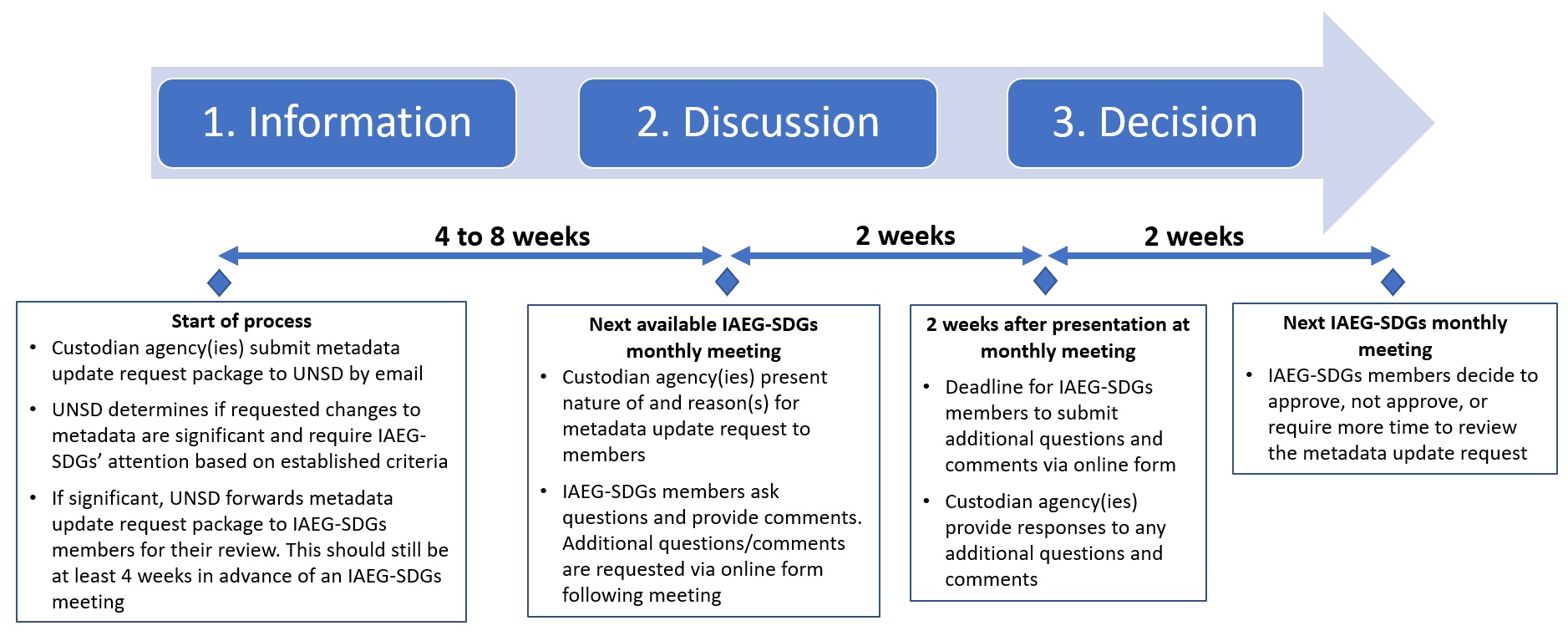SDG Indicators
Metadata repository
The metadata available in this repository is a work in progress. It reflects the latest reference metadata information provided by the UN System and other international organizations on data and statistics for the Tier I and II indicators in the global indicator framework. This repository will be further updated and periodically reviewed in cooperation with the respective data compilers.
In addition:
- Official list of Global Sustainable Development Goal indicators
- Tier Classification for Global SDG Indicators
- Previous Work Plans for Tier III Indicators (archive)
- Metadata for initially proposed indicators (archive)
Metadata update process:
Methodology for indicators is expected to update from time to time. For any metadata updates that include significant changes (detailed in the form below), the IAEG-SDGs will review the changes during its member meetings based on the update request form (see below) and track change metadata provided. Custodian agencies will also be invited to attend an upcoming IAEG-SDG member meeting to present on the proposed changes and answer any questions.
As requested by the IAEG-SDGs, custodian agencies must provide their metadata update request documents at least one month in advance of their next scheduled meeting to allow for sufficient time for review. Depending on the time of submission and the next IAEG-SDG member meeting, the timeline for review and approval can span up to 12 weeks or more. Therefore, it is important to provide submissions as soon as they are available. Please note that no data are published in the Global SDG Indicators Database until the corresponding metadata is approved by the IAEG-SDGs.
Please see below the projected stages and timeline.
To get started, custodian agencies are requested to:
- Download the metadata Word file for the indicator from the metadata repository (below) and edit the Word file in track changes to show the requested changes.
- Custodian agency downloads and completes the “Metadata update request form” (below) and sends the request package to sdgindicators@un.org.
Search
Goal 2. End hunger, achieve food security and improved nutrition and promote sustainable agriculture
Target 2.1: By 2030, end hunger and ensure access by all people, in particular the poor and people in vulnerable situations, including infants, to safe, nutritious and sufficient food all year round
- Indicator 2.1.1: Prevalence of undernourishment
- Indicator 2.1.2: Prevalence of moderate or severe food insecurity in the population, based on the Food Insecurity Experience Scale (FIES)
Target 2.2: By 2030, end all forms of malnutrition, including achieving, by 2025, the internationally agreed targets on stunting and wasting in children under 5 years of age, and address the nutritional needs of adolescent girls, pregnant and lactating women and older persons
- Indicator 2.2.1: Prevalence of stunting (height for age <-2 standard deviation from the median of the World Health Organization (WHO) Child Growth Standards) among children under 5 years of age
- Indicator 2.2.2: Prevalence of malnutrition (weight for height >+2 or <-2 standard deviation from the median of the WHO Child Growth Standards) among children under 5 years of age, by type (wasting and overweight)
- Indicator 2.2.3: Prevalence of anaemia in women aged 15 to 49 years, by pregnancy status (percentage)
- Indicator 2.2.4: Prevalence of minimum dietary diversity, by population group (children aged 6 to 23.9 months and non-pregnant women aged 15 to 49 years)
Target 2.3: By 2030, double the agricultural productivity and incomes of small-scale food producers, in particular women, indigenous peoples, family farmers, pastoralists and fishers, including through secure and equal access to land, other productive resources and inputs, knowledge, financial services, markets and opportunities for value addition and non-farm employment
- Indicator 2.3.1: Volume of production per labour unit by classes of farming/pastoral/forestry enterprise size
- Indicator 2.3.2: Average income of small-scale food producers, by sex and indigenous status
Target 2.4: By 2030, ensure sustainable food production systems and implement resilient agricultural practices that increase productivity and production, that help maintain ecosystems, that strengthen capacity for adaptation to climate change, extreme weather, drought, flooding and other disasters and that progressively improve land and soil quality
- Indicator 2.4.1: Proportion of agricultural area under productive and sustainable agriculture
Target 2.5: By 2020, maintain the genetic diversity of seeds, cultivated plants and farmed and domesticated animals and their related wild species, including through soundly managed and diversified seed and plant banks at the national, regional and international levels, and promote access to and fair and equitable sharing of benefits arising from the utilization of genetic resources and associated traditional knowledge, as internationally agreed
- Indicator 2.5.1: Number of (a) plant and (b) animal genetic resources for food and agriculture secured in either medium- or long-term conservation facilities
- Indicator 2.5.2: Proportion of local and transboundary breeds classified as being at risk of extinction
Target 2.a: Increase investment, including through enhanced international cooperation, in rural infrastructure, agricultural research and extension services, technology development and plant and livestock gene banks in order to enhance agricultural productive capacity in developing countries, in particular least developed countries
- Indicator 2.a.1: The agriculture orientation index for government expenditures
- Indicator 2.a.2: Total official flows (official development assistance plus other official flows) to the agriculture sector
